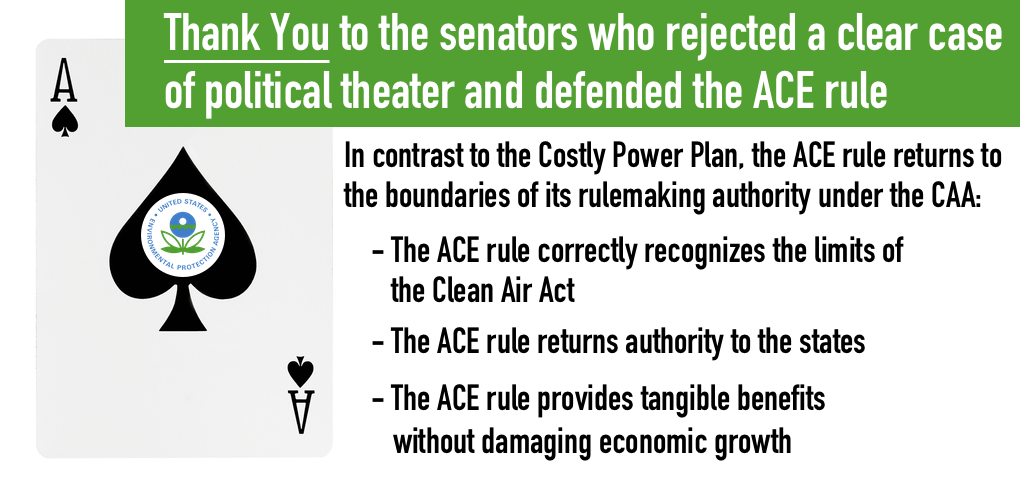
A Symbolic Vote Against Voter Preference
Remember the Clean Power Plan (CPP)? Designed to shutter coal plants and with the potential for economic destruction, the U.S. Supreme Court stayed it and this administration wisely replaced it with a legal alternative: the Affordable Clean Energy (ACE) rule. But just when we thought reason might prevail, enter the Senate democrats who earlier today held a vote to repeal the ACE rule. The vote proved to be symbolic, never coming within reach of the votes needed for repeal but it served as a timely reminder of how out of touch some lawmakers are with voter preference and legal reality.
NMA’s president and CEO, Rich Nolan, applauded the majority of senators that stood up in defense of the ACE rule and “rejected a clear case of political theater.” He continued, “The ACE rule shows that it is possible to advance the nation’s environmental protections while preserving the rightful authority of the states to manage their own unique energy infrastructure and electric grids. Unlike the prior administration, this EPA has chosen to follow the law instead of picking winners and losers, and through that path has paved the way for a smart, all-of-the-above energy strategy that makes affordable, reliable electricity accessible for all Americans.”
Recall that the CPP was – among a long list of flaws – little more than an anti-coal measure. While Americans were told time and again that the previous administration was pursuing an all-of-the-above energy strategy, the words never matched the actions.
Recent polling from Morning Consult found that 70 percent of Americans want the U.S. to pursue an all-of-the-above energy strategy that includes natural gas, coal, renewables and nuclear power. The very same polling found that a majority of Americans support government action to upgrade the nation’s coal fleet. The ACE rule allows these objectives to be met, while reducing emissions, and does so – unlike the CPP – legally. Where the CPP was defined by regulatory overreach, the ACE rule returns to legally-sound restraint. Here are the key differences between the two rules:
- The ACE Rule Correctly Recognizes the Limits of the Clean Air Act: The Clean Air Act (CAA) allows the EPA to regulate emissions from individual power plants, not mandate the rebuilding of the entire electric grid by forcing the adoption of politically preferred sources of power as the CPP proposed to do. In fact, when challenged in federal court by a majority of states, the CPP’s implementation was stayed by the U.S. Supreme Court, which recognized the immediate economic threat of the rule. By contrast, the ACE rule returns to the boundaries of its rulemaking authority under the CAA.
- The ACE Rule Returns Authority to the States: The CPP forced a one-size-fits-all approach on states, dictating a sweeping overhaul of their electricity grids. The ACE rule rejects such dramatic federal overreach, honoring the CAA’s system of shared authority, respecting the infrastructure and economic realities that are unique to each state, and allowing for state-driven solutions rather than top-down federal mandates.
- The ACE Rule Provides Tangible Benefits Without Damaging Economic Growth: Unlike the CPP, the ACE rule provides a proven path to emissions reductions without imposing crippling costs on consumers. The ACE rule is expected to continue to cut emissions while also reducing the compliance burden imposed on consumers by hundreds of millions of dollars annually when compared to CPP. More than 40 states would have been saddled with double-digit increases in the cost of wholesale electricity under the CPP. Sixteen states would have been particularly hard hit, facing wholesale power price increases in excess of 25 percent.
The CPP was also regressive, placing an undue burden on low and fixed-income families that can least afford it. As the U.S. Energy Information Administration (EIA) has reported, one in three American households are already facing challenges in paying energy bills. Coal country would have been gutted. According to EIA’s analysis of reduced demand for coal under the plan, coal-related employment would have fallen by 127,000 high-wage jobs by 2040. Conversely, the ACE rule will provide meaningful environmental benefit while lowering compliance costs, ensuring affordable and reliable energy, and preserving high-wage jobs.
Those opposed to the ACE rule, those still pining for the days of federal overreach and regressive costs, should be very careful of just what they’re wishing for. Soaring energy costs – especially those forced on consumers by bad energy policy – would seem to be kryptonite. Voters are clear about what they want with U.S. energy policy. Maybe instead of casting symbolic votes for failed policies, it’s time to listen.
- On October 17, 2019
